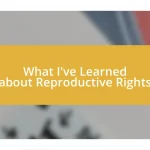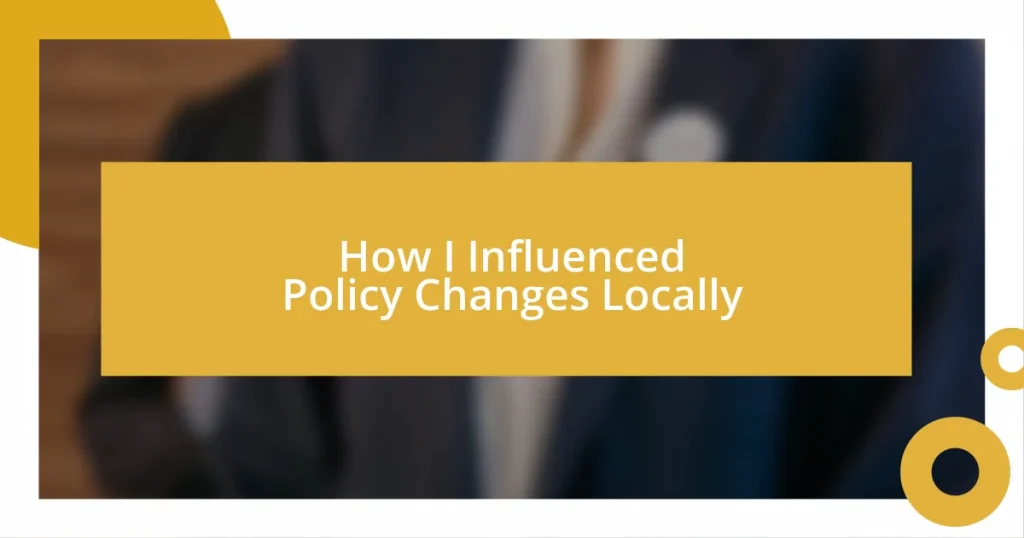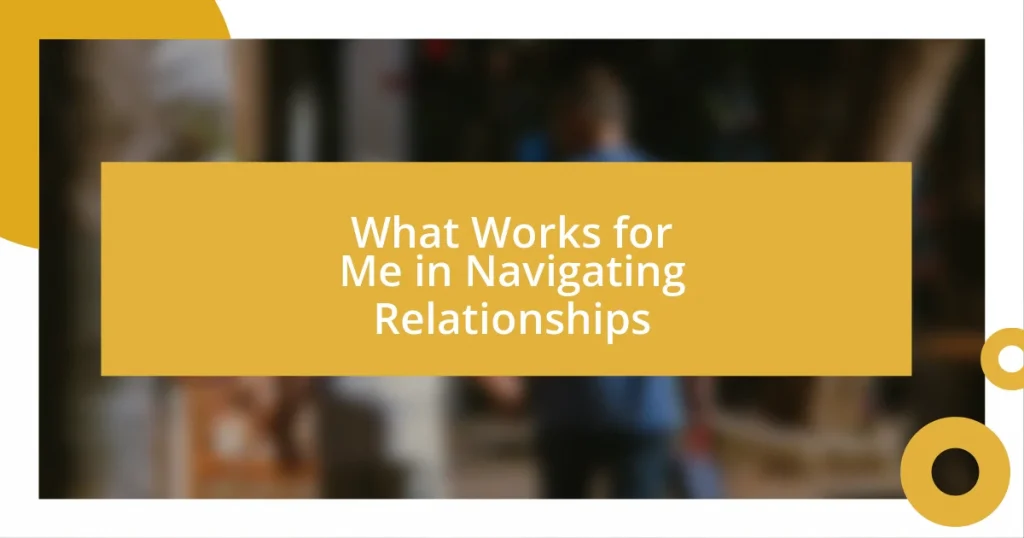Key takeaways:
- Engaging with local leaders and sharing personal stories can significantly influence policy decisions and enhance discussions.
- Identifying and collaborating with key stakeholders, including community members and local organizations, creates a broader support network for initiatives.
- Utilizing data and effectively communicating successes, including celebrating small wins, is essential for maintaining community engagement and momentum in advocacy efforts.
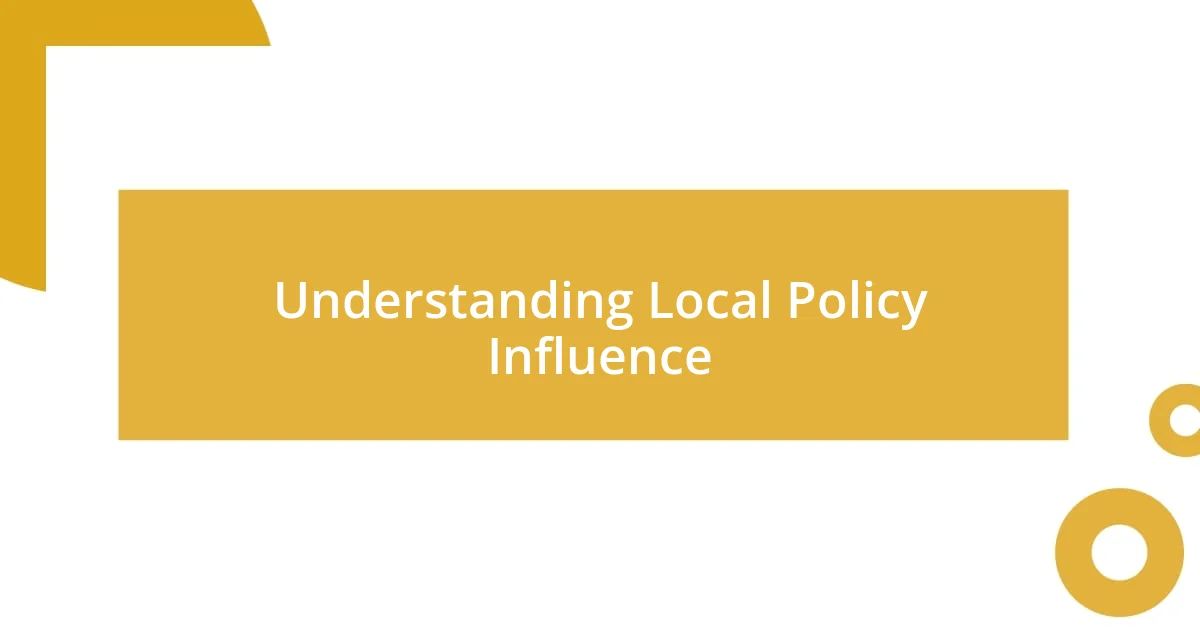
Understanding Local Policy Influence
Understanding local policy influence is often about recognizing the power that individuals and communities hold. I still remember the day I attended a town hall meeting; the energy in the room was palpable as residents voiced their concerns. It struck me then that our voices, collectively, could shape decisions that affect our daily lives.
Have you ever felt that burning desire to see change in your community? I certainly have. I took it upon myself to connect with local leaders, sharing not just data but personal stories that resonated with their experiences. These real-life accounts often make the numbers come alive, prompting more authentic discussions around policy.
Building relationships with local policymakers is crucial. I learned that informal conversations could lead to powerful breakthroughs. I once casually chatted with a council member at a community event, which ultimately opened the door for later discussions on a project I was passionate about. It’s these small moments that highlight the importance of being engaged and present in our local political spheres.
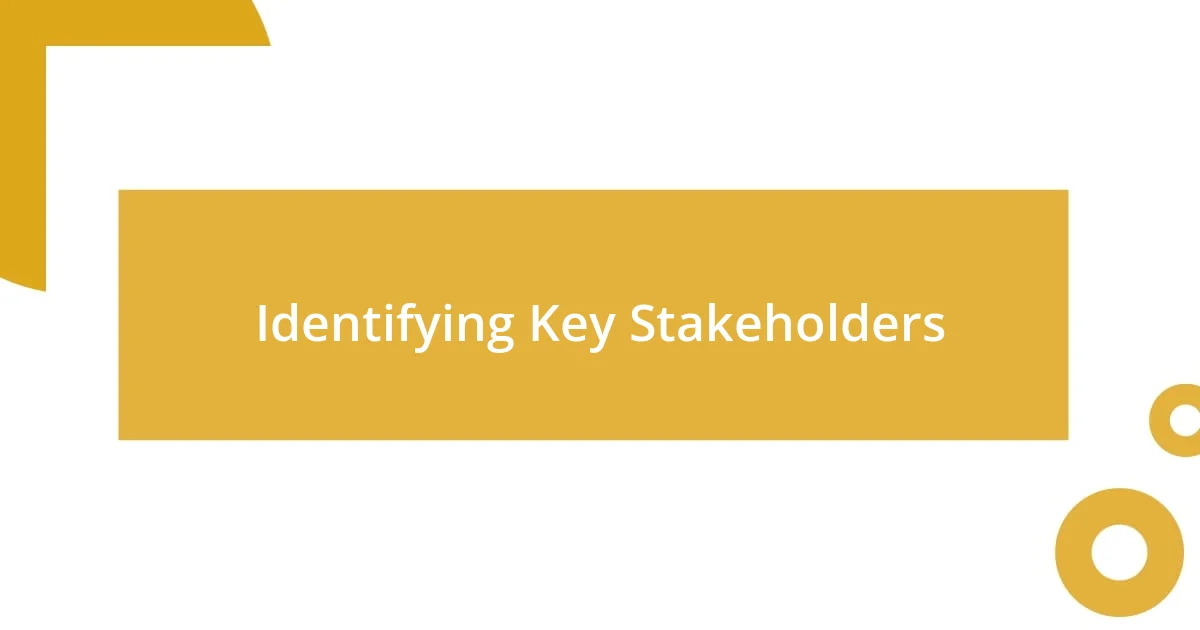
Identifying Key Stakeholders
Identifying key stakeholders is a critical step in any local policy influence effort. I found this out firsthand when organizing a community initiative focused on environmental sustainability. In my early discussions, I realized that engaging with not just elected officials but also local business owners, community activists, and educators significantly broadened our reach. Each of these groups had unique insights and resources, enriching our mission.
To effectively identify and engage stakeholders, consider these crucial aspects:
- Influence: Who holds power in decision-making processes?
- Interest: What is their stake in the issue at hand?
- Connection: How can they connect you to others who can help?
- Motivation: What drives them toward or away from your goals?
- Accessibility: Are they willing and available to engage in dialogue?
By asking these questions, I found stakeholders who shared my vision and were eager to collaborate. This approach not only amplified our message but also fostered a sense of community investment in the policy changes we sought.
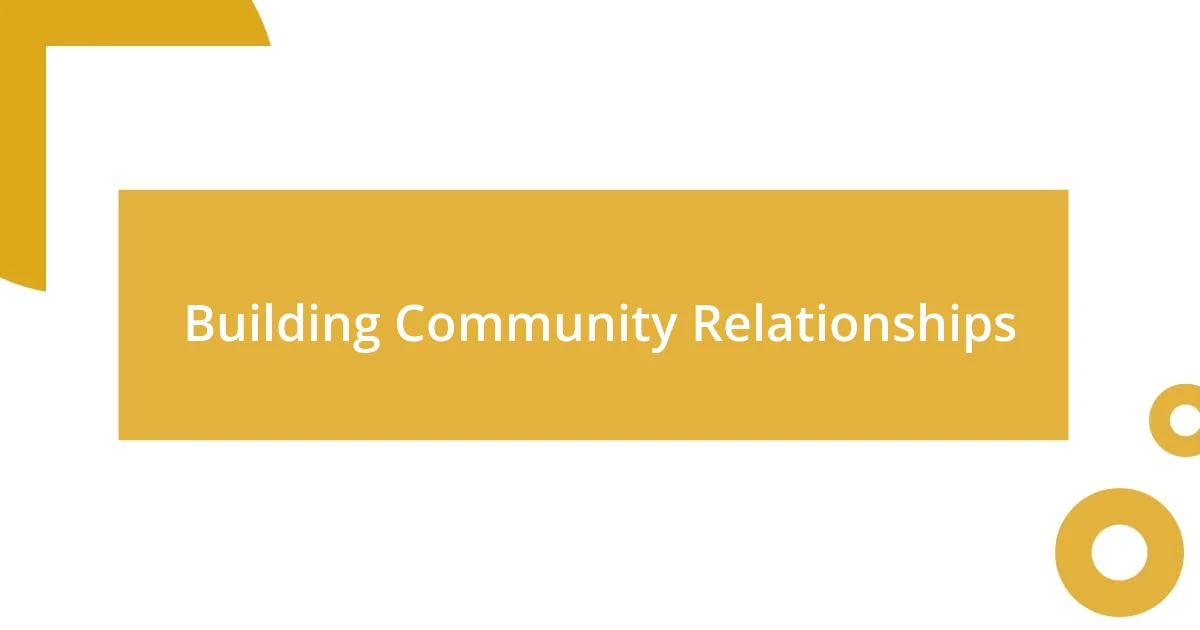
Building Community Relationships
Building community relationships is a vital part of influencing local policies. I remember a time when I hosted a small neighborhood gathering to discuss our community garden project. As we sat together, sharing food and ideas, I felt a sense of camaraderie that sparked a deeper desire to collaborate. It became clear that forging these personal connections allowed us to voice our collective ambitions more effectively and comprehensively. Wouldn’t you agree that shared experiences can ignite passion in our pursuit of change?
In my journey, I discovered that genuinely listening to the concerns of others is just as important as sharing my own perspectives. At a community meeting, a single conversation with a resident revealed their struggles, which I hadn’t understood before. This moment shifted my focus and highlighted the necessity of empathy in our discussions. It’s through these relationships that I’ve found innovative solutions to our community’s challenges, proving that we’re often stronger together.
Taking the time to nurture these relationships leads to unanticipated opportunities. For instance, I found that volunteering alongside local organizations opened doors to conversations with leaders I wouldn’t have approached otherwise. These interactions often blossomed into partnerships that enhanced our projects’ visibility and credibility. That’s when I realized: it’s not just about talking; it’s about building a network of trust and support that can truly drive impactful change.
| Personal Connection | Empathy in Action |
|---|---|
| Gathering community members fosters excitement for shared goals. | Listening deeply allows us to better address specific concerns. |
| Community relationships create an environment where ideas flow freely. | Genuine connections can reveal innovative solutions to challenges. |
| Engaging interpersonally breaks down barriers between neighbors. | On-the-ground volunteering leads to unexpected partnerships. |
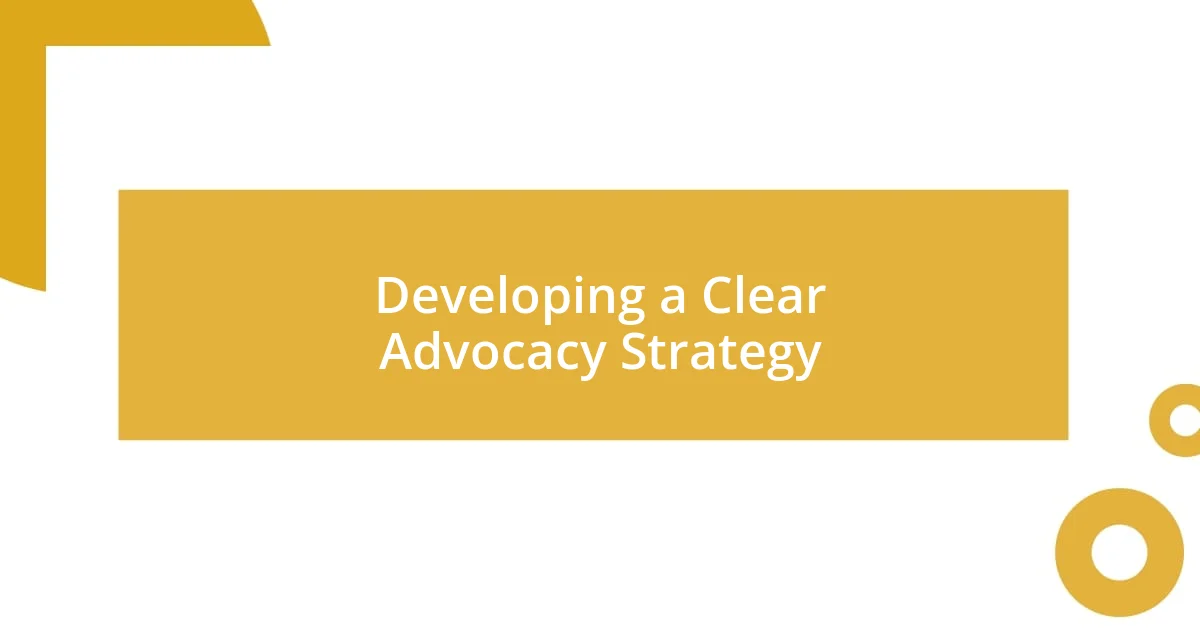
Developing a Clear Advocacy Strategy
Developing a clear advocacy strategy involves setting specific goals and identifying the methods to achieve them. I vividly recall a strategy session where we sat together and brainstormed what we wanted to change in our community. It was in that moment I realized that articulating our objectives concretely allowed us to align our efforts, channeling our energy in a focused manner. Have you ever felt that rush of clarity when everyone is on the same page? It’s exhilarating!
Once our goals were established, we turned to mapping out our approach. This meant choosing the right tactics—be it grassroots campaigns, public forums, or social media outreach. I remember feeling the importance of storytelling as a powerful tool in our strategy. By sharing personal experiences connected to our mission, we could evoke emotion and passion, making it harder for decision-makers to ignore our cause. Wouldn’t you agree that a compelling narrative can be more persuasive than mere statistics?
Finally, I learned to set timelines for our advocacy efforts. At one point, we created a calendar for our initiatives, marking key dates for advocacy, meetings, and community events. This helped us stay accountable and maintain momentum. It’s fascinating how having specific targets can keep a group motivated and organized. When was the last time you set a clear timeline for something important? That sense of purpose can transform an ambitious idea into a reality!

Utilizing Data and Research
When it comes to influencing policy, utilizing data and research is imperative. I remember diving deep into local statistics about youth homelessness in our area. Armed with this information, I felt empowered to approach local leaders, showing them just how urgent the situation was. The look on their faces when I presented the numbers was priceless; it was a mix of surprise and determination to act. Have you ever seen a shift in perspective happen right before your eyes?
In my experience, presenting data isn’t just about numbers; it’s about weaving a narrative that makes those numbers resonate. I once conducted a survey among community members, and I was astonished by how their individual stories echoed the data. They painted a picture that statistics alone couldn’t convey. By showing how research aligns with real-life experiences, I found a potent way to advocate for change. Don’t you think that combining the emotional with the factual can be a game-changer in advocacy?
Moreover, collaborating with local universities for research support can amplify our voice. I remember teaming up with a group of students for a project that analyzed environmental impacts in our neighborhood. Their fresh perspectives, combined with academic rigor, provided evidence that we could present at town hall meetings. It was exhilarating to realize we were not just spouting opinions; we were armed with data that demanded attention. Isn’t it remarkable how the right partnerships can strengthen our cause?
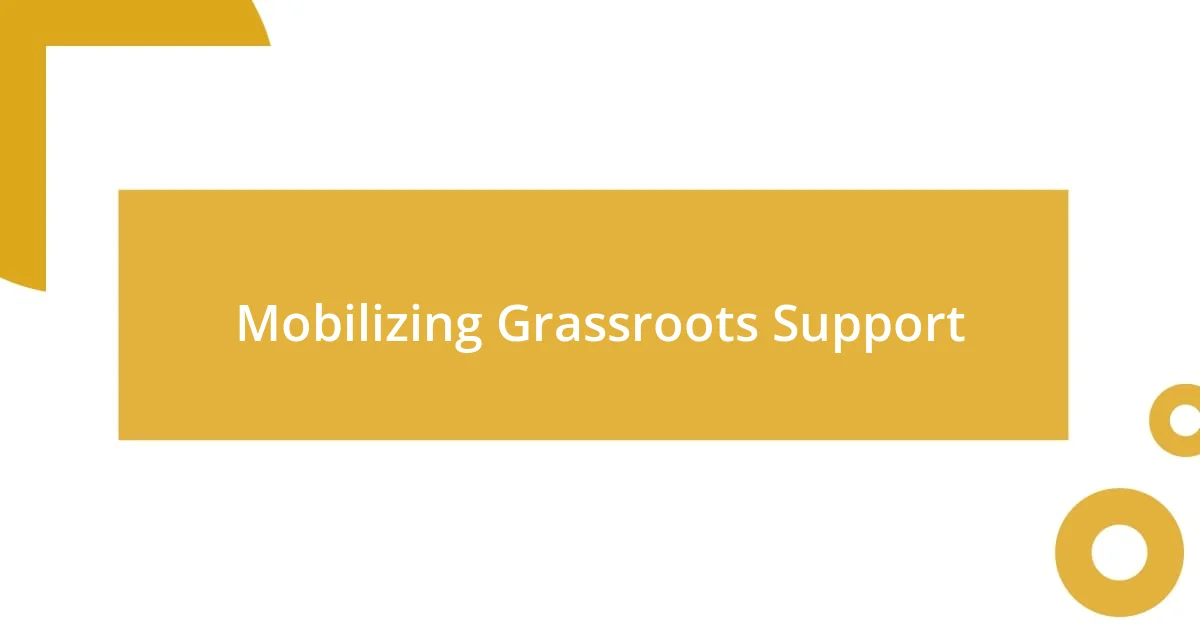
Mobilizing Grassroots Support
Mobilizing grassroots support is all about creating a community that feels empowered to voice its concerns. I remember the first time I attended a neighborhood meeting; I was amazed at the passion people had for issues affecting our community. That energy was contagious! It reinforced my belief that when individuals unite around a common cause, their collective influence can change the narrative. Have you ever witnessed a group come together and felt that electricity in the air?
In my journey, I discovered that using social media effectively can galvanize grassroots movements quickly. I started a local Facebook group to share updates and encouragement for our advocacy efforts, and the response was overwhelming. Suddenly, community members who had never spoken out before began sharing their experiences and ideas. It became a safe space for dialogue, sparking a sense of ownership among participants. Isn’t it fascinating how digital platforms can create a bridge between people who may have never met otherwise?
Texting and phone calls also play a crucial role. I implemented a simple system where we would send reminders about local events and calls to action. The personal touch of reaching out through direct messages ensured that members felt valued and engaged. I’ll never forget the warmth of one member’s reply, thanking us for keeping everyone informed. It’s incredible how small gestures can foster a real sense of community, don’t you think? Building solidarity and encouragement are essential ingredients for mobilizing grassroots support.
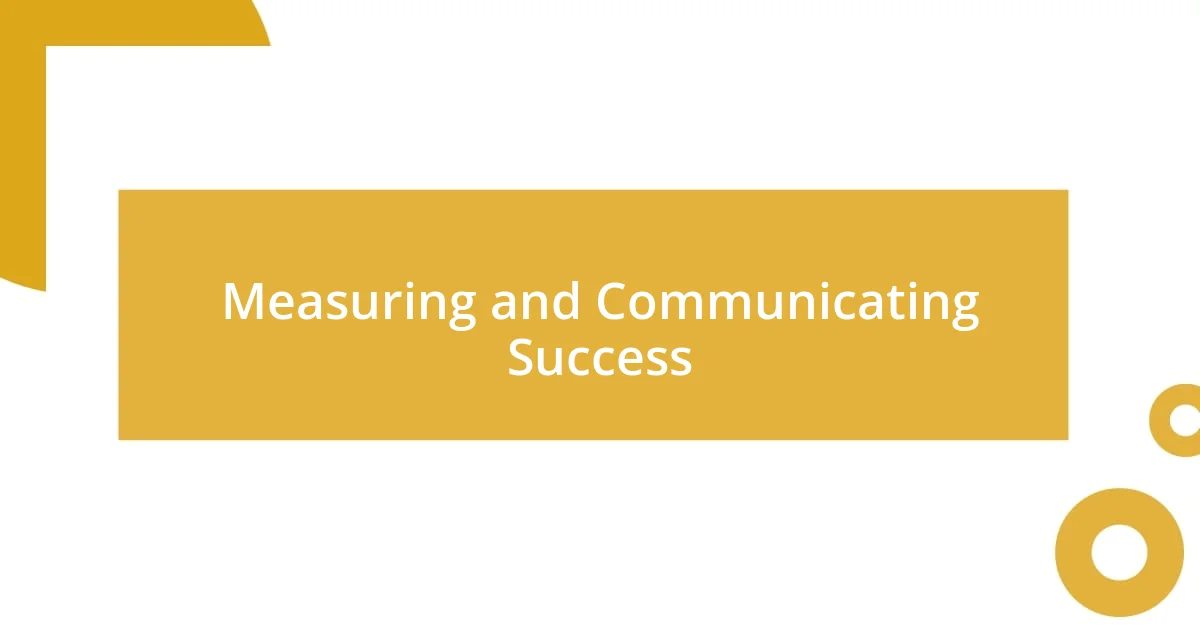
Measuring and Communicating Success
Measuring success in advocacy is not just about tallying votes or counting attendees; it also involves understanding the impact of our actions. Once, after a campaign to improve local park facilities, I conducted follow-up surveys to gauge community sentiment. Seeing the shift in responses was deeply rewarding—it felt like a validation of our collective efforts. Have you ever identified a change in public opinion and felt that rush of accomplishment?
Communicating that success is equally important. I decided to create an engaging infographic highlighting the improvements and feedback from residents. Sharing it at community meetings and on social media sparked conversations about future initiatives. I was thrilled when neighbors approached me, eager to build on our momentum. Isn’t it amazing how visual storytelling can bring our achievements to life and continue inspiring action?
Lastly, I learned that celebrating small wins can boost morale and encourage ongoing engagement. After we secured funding for the park, I organized a community gathering to celebrate. The joy on everyone’s faces reminded me that this work is about more than policies; it’s about people. How do you think recognizing these milestones influences the community’s passion for future projects?






